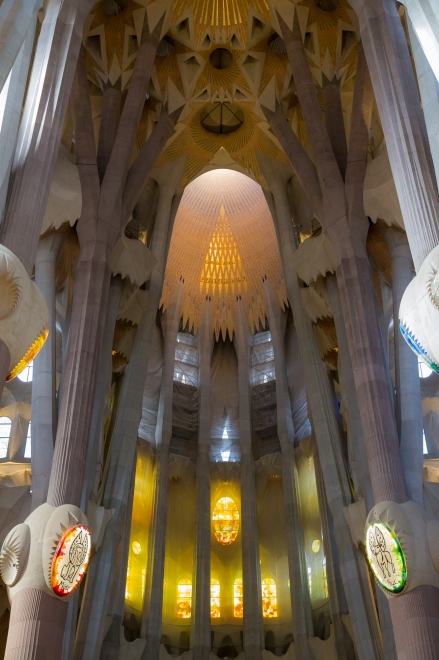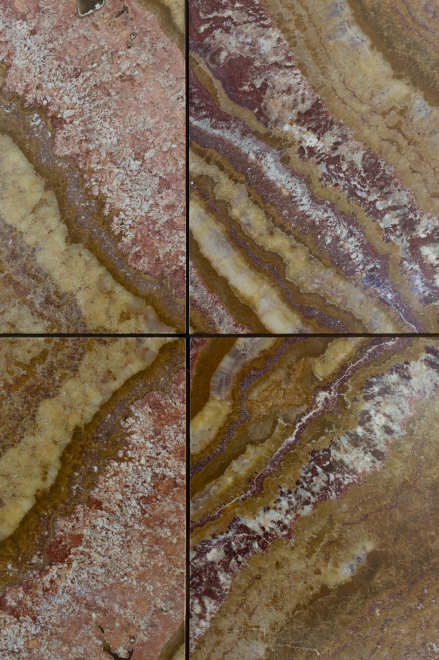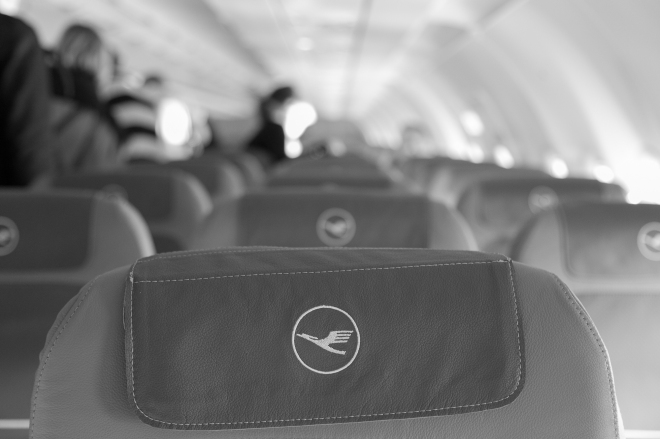I was fortunate to travel most of the weekends that I was in Stuttgart in 2011. In particular, much of my travel then (as even now, in hindsight) was focused on hiking locations, and there ended up being fewer actual visits to cities than what completed lists of suggested locations from friends would have shown. One such location was Barcelona: several friends described it as being their favorite city in their time abroad, but with mountains calling I never made it there. I finally was able to visit some friends who chose it as a temporary reprieve from the Illinois winter. Initially uneasy that I would give up on an already dry and warm winter, in hindsight I’m glad the trip worked out, because the city is a bright, lively destination. No wonder the locals stay out as long as they do!
As my first visit to a Spanish-speaking country, I didn’t absorb some of the cultural nuances as well as I could have in, say, France or Germany. The same is true of many of the museums, which had exhibit descriptions in either Spanish or Catalan. The Roman frescoes recreated from ancient churches and buildings we saw at the Museu Nacional d’Art de Catalunya were beautiful but with signs in Spanish and Catalonian I couldn’t read about their whereabouts or background.
It’s not just the museums of Barcelona that are appealing, however. Streets, and even alleys, are eminently walkable (read: safe) and the gridwork formed by them is interesting from the ground up.
There were also some local artisan shops; I popped quickly into a sunglass store to see whether the owner had a polarized, hipster pair (he did not, but the styles were nevertheless thoughtful!).
The following morning, my friends and I visited the Barcelona Cathedral, where inside the congregation was preparing for Sunday Mass.
Outside, I was intrigued by a band and local Catalonians dancing the Sardana, which originated elsewhere but spread to Catalonia one hundred years ago.
For over two hours the group of eleven musicians played traditional music on the steps of the cathedral, which gave the morning an energy I admittedly haven’t seen in Kempten so far beyond its Festwoche in August. (That energy is largely attributable to a different reason, however!)
Until this point, the art and architecture was impressive but didn’t prepare me for that afternoon’s stop, arguably the architectural highlight of my time in Barcelona: the Sagrada Família. The nuances of the building I’m about as far from being familiar with as it gets, but its majesty — even as construction continues to swirl around it — is undeniable.
The attention to detail is not just on the exterior, however. I was not the only one whose jaw dropped at the magnificent ceilings and elaborate detail; it’s difficult to really capture the enormity, both spiritual and design, of the immense interior.
What is maybe most incredible about the construction of the cathedral is not that such a design is conceivable; it is that one person envisioned it and began laying plans for its construction without the tools that today’s architects and civil engineers use everyday. The result of that vision is a sweeping interior that is bright but yet somber, modern though tactful, calming yet somehow inquisitive.
After visiting the Sagrada Família, we walked back to the city center to tour two other museums before their free hours ran out (this is a terrific aspect of Barcelona, by the way — it is refreshing to see a city committed to preserving arts for the enjoyment of its people by way of reduced or eliminated entrance fees). The first was the Museu d’Historia de Barcelona, or MUHBA for short, at its Plaça del Rei location. Dozens of feet below the city street laid ruins that formed Roman Barcino.
The next stop was at the Maritime Museum, which impressed first with a massive exhibit of a replica of a medieval rowing galley. The museum wasn’t hugely busy, making the this ship especially appear even larger.
In another wing of the museum, another reconstruction was underway. The craftwork was impressive; it reminded me of similar dedication at the Deutsche Bahn Museum in Nürnberg.
The final morning of my stay in Barcelona, I headed to the van der Rohe Pavilion, a building designed by Mies van der Rohe for the German National Pavilion for the Barcelona International Exhibition in 1929. van der Rohe actually ran the Bauhaus art house in Berlin for some years, but as I’m unfamiliar with the specifics of the movement (even after visiting its museum!) I wasn’t familiar with his name. The Pavilion was smartly designed and actually quite refreshing; unlike the hustle of Barcelona and the neighboring Plaça d’Espanya, the Pavilion was tranquil and rather soothing.
While I didn’t recognize the name, the work of van der Rohe is familiar to Chicagoans. Apparently, Chicago is the only city to have learned his lessons properly. Fair point; the buildings he worked on there are rather staples of the skyline or campuses they belong to.
I had seen occasional photos of elevated views of Barcelona while walking through the city and looking at tour guides, so coupled with my lack of snowsports and elevation this winter, I sought out possible vantage points upon which to view Barcelona from above. The first stop was actually an amusement park on Mount Tibidabo that sits at the foot of the Sagrat Cor church, which though far removed from the city and its rich art had a beautifully ornate interior of its own.
It’s therefore hard to tell if the views down to the city below inspired the detail of the church decorations or vice versa. Below Tibidabo and its odd interplay between religion and amusement park, the city of Barcelona spread out and touched the Mediterranean.
A second recommendation for views over the city was at the Bunkers of Carmel, also known as Bunker Turo de la Rovira. The directions to them are rather paltry online, but bus 119’s terminus stop (Panorama-Labèrnia) is effectively at the bottom of a short flight of stairs that lead up to the bunkers. (The stop Alfons X of the metro Line 4 is also a possible disembarkation point, but it requires much more effort to reach the bunkers from here as it’s entirely uphill for about fifteen minutes.) A little closer to town, the views reveal even clearer the density of Barcelona and its proximity to the warm waters of the Med. The evening sunlight, too, was warm, and even on a workday dozens of visitors watched the skies turn from blue-grey to blue to black.
By taking the bus, the Bunkers required little physical effort to arrive at, but Tibidabo can be a different story. It is achievable either directly through a series of public transportation options that culminate in a funicular ride (privately owned) or via a 1-mile walk up the main road from the town of Vallvidrera. Taking either train S1 or S2 to Peu del Funicular will deposit you a different funicular from the one mentioned above (this time part of Barcelona’s public transport network). The main road uphill first winds through residential neighborhoods then swings by the TV tower, Torre de Collserola. That evening, while at the Bunkers watching the sun set behind the Tibidabo hills, I turned my camera away from the city below me and glanced back at the hill I had walked up that morning. This time, I couldn’t hear the creepy sounds of the wind whistling through the TV tower.
As we descended from the Bunkers toward the city, we crossed a small, deserted viewing platform. A ledge there became a surrogate tripod with which to grab a final picture of Sagrada Família.
And that was it. A whirlwind of four days in a city I didn’t expect to visit in winter, a city I didn’t expect to be entirely comfortable with given its carefree ways and my sometimes-inflexible travel plans (particularly with regard to sleeping in). My worry was that I’d be kept awake by partiers and a general laissez-faire attitude while not being able to understand the language whatsoever, but classical art, friendliness, and modernist architecture speaks in tongues not defined by words or grammar. I imagine this pleasant-surprisedness to be the feeling that many Americans get by visiting Charleston: an easy-going city, delicious food options, next to warm water. It’s true I love mountains, but as Mark Vanhoenacker correctly points out in his Skyfaring,
“We say we love the sight of [mountains], this land above all others; yet all we see is water.”
And it’s accurate, of course. The white-blue expanse I so often chase is really just a blue-blue expanse, only much higher in the sky — but very much made of the same elements I sought to escape from time to time while in Charleston.
My delayed flight to Munich gave me time to think about how incredible this city by the sea was, but it also gave me one last parting gift from Barcelona: a plane ride I didn’t expect. I was supposed to be on an A321, but what pulled up 90 minutes late was no A321.
Earlier this year, a plane significant for the next generation of air travel flew its first commercial flight (no, not the Swiss 777-300ER!): the Airbus A320neo, neo for “new engine option,” was delivered to Lufthansa in February. The predecessor to this plane (the A320, or A320ceo — classic engine option) arguably gave Airbus a foot in the door of a commercial aviation industry then dominated by Boeing and McDonnell Douglas, and as I was walking slowly around the gate waiting for boarding, I noticed a shiny, newly-painted jet roll up to the jetbridge. At first I thought maybe Lufthansa had begun to install winglets on its A320 fleet, but when I pulled up the tail number I was astonished to read that I’d be flying on my second brand-new jet this year. (That makes a UA 787-8, the Swiss 77W, and now the A320neo as being chance encounters on recently-delivered aircraft.) The interior still smelled new and the seats still undamaged.
As we pushed back, a vueling A320 landed. While the A320 platform isn’t as old as the 737 family, its history and its success is certainly worthy of business school case studies.
Although on a new plane, this flight was far less sentimental for me than the Swiss flights the week prior, but I was still giddy as we pulled away from the gate. I’m not sure that Barcelona is my favorite European city, but the levels of its warmness and richness alike caught me completely off-guard.
Our flight plan took us out over the Mediterranean with the buildings of Barcelona becoming quickly smaller. We were delayed enough that the Austrian Alps below us were soon in shadow, but the sun behind the new distinguishing feature of the A320neo family was an exclamation point to two weekends of seeing friends, exploring new European cities, and putting aside my expectations and biases (if only for a moment!). To this end, what intrigues me most about Europe is not the thousand-plus kilometer stretch of solitude and peace jutting up to 4000 m skyward; it’s rather that flying only an hour can bring me to a country with a completely different language and culture. It can be argued that the US has various micro-cultures around its regions, of course, but we all speak the same language and generally enjoy the same rights regardless of state border. Experiencing a new set of values and a belief system is without doubt enticing, potentially even more so than being among the clouds, but trying to understand how it all functions together as a commonwealth of largely disparate peoples is an exercise in both patience and curiosity I am beyond fortunate to experience over the next few years. Kudos to Barcelona for being such a surprise and showing me just how incredible this part of the continent really is.





























So glad you got to spend 4 days in “Barsa” which is about how long we were there last year. Your outstanding photography blew me away – as usual.
We did take the funicular (the one that is part of the Metro) but I missed the other high overview sites you caught so splendidly. Did not see any mention of the Gaudi buildings ( http://www.globotreks.com/destinations/10-gaudi-buildings-barcelona/) that we loved so much. He, of course, is the dreamer who started the Familia Cathedral. Maybe I’ll plan a return trip in 2024 when they say it will be completed.
Thanks for taking a look as usual!
I never made it inside the Gaudí houses (or to Park Guell, which also had a good overlook over the city). I’d like to go back sometime and have those on the list, though ideally when it’s warmer out and when the city comes alive for its beaches. While the temperatures were balmy for “winter,” the Med was still a bit cold for passive lounging!
Nice info and great photography
Thanks — we can of course chat more about specifics this week!